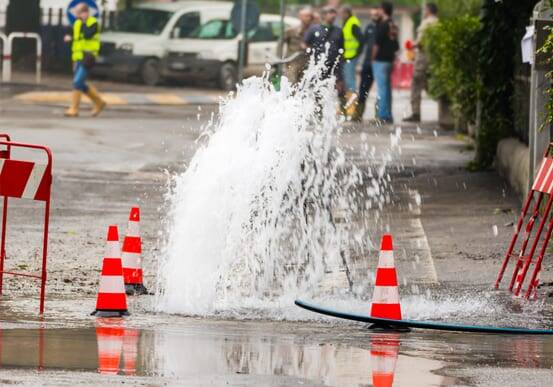You’ve reached your limit!
To continue enjoying Utility Week Innovate, brought to you in association with Utility Week Live or gain unlimited Utility Week site access choose the option that applies to you below:
Register to access Utility Week Innovate
- Get the latest insight on frontline business challenges
- Receive specialist sector newsletters to keep you informed
- Access our Utility Week Innovate content for free
- Join us in bringing collaborative innovation to life at Utility Week Live

Asset management experts from Thames and SES Water set out key challenges and potential enablers of proactive maintenance regimes as they strive to replicate ‘suspiciously low’ leakage levels achieved in the Netherlands.
Providing an update on the Netherlands’ drinking water mains rehabilitation landscape at a recent Utility Week conference, Ralph Beuken – a scientific researcher at water research institute KWR – explained that while network performance is currently “high” more capex will be required to face new challenges demanding new and more adaptable infrastructure between now and 2050.
 This comes off the back of reporting by Ofwat, and joint research by UKWIR and KWR, that found “suspiciously low” Dutch leakage levels since the turn of the century.
This comes off the back of reporting by Ofwat, and joint research by UKWIR and KWR, that found “suspiciously low” Dutch leakage levels since the turn of the century.
Field tests by UK companies between 2003 and 2005, for example, saw Bristol Water record two leaks across the Hague’s 19km network, Essex and Suffolk Water register a single leak across a 16km rural segment and Yorkshire Water declare Amsterdam leak-free.
At present, all leaks are visible according to Beuken, who added that the Netherlands’ network doesn’t use cast iron and operates at low pressure. This 120,000km system – 54% of which is made from PVC – also carries water mostly sourced from groundwater, with no chlorination used and, in accordance with drinking water laws, tap water temperature capped at a maximum of 25°C. What’s more, 100% of homes are connected to the water network and metered – versus 95% and 57% in the UK respectively.
 Yet, while the current average mains replacement rate is 0.8%, this is expected to increase in the next decade amid challenges heralded by climate change, the need to incorporate new technology, and the potential impact of more pipes in the ground as a consequence of the rollout of heat networks, for example.
Yet, while the current average mains replacement rate is 0.8%, this is expected to increase in the next decade amid challenges heralded by climate change, the need to incorporate new technology, and the potential impact of more pipes in the ground as a consequence of the rollout of heat networks, for example.
The impact of energy transition via subsoil damage, new cisterns, wells and soil disturbance caused by new infrastructure, for instance, poses the potential challenge of whole system reconstruction according to Beuken.
These challenges and more await UK water networks in the coming years given current leakage and maintenance performance lags behind their Dutch counterparts. However, progress is being made via asset visibility projects outlined by Thames and SES Water, for example.
Adopting a holistic trunk main risk model
Discussing the role of risk management to better manage failing assets, Thames Water’s head of London planning, Simon Moore, set out the firm’s proactive approach to replacing trunk mains. Described as the “motorways” of the water network, according to Thames, trunk mains carry a significant amount of water at high pressure.
Thames, which provides water and wastewater services to 15 million people, oversees a network which includes some 3,600km of trunk mains comprising around 10% of its network – some of which are up to 200 years old.
Following eight separate bursts in 2016, the firm conducted a series of internal reviews and subsequently developed a more holistic trunk main risk model prioritising investment, replacement and repair, and the deployment of monitoring devices.

Moore described the replacement rate as “very low” – less than 1% per AMP – with 45% of mains pre-WW2 and 15% more than 150 years old, therefore demanding a more proactive approach to maintenance and three key areas of improvement.
Firstly, gauging the likelihood of trunk main failure and establishing models to help get closer to predicting when and where assets will fail. This, Moore explained, involves extensive testing and drawing deterioration curves for materials that the network is made out of such as cast iron. Such work at the Jeff Farrow Test Rig has provided a library of more than 1,000 trunk main datasets, for example.
Secondly, Moore added that Thames is in the midst of rolling out in-pipe condition assessment devices that have a “benign” effect on water quality and trunk main assets and ability to assess long lengths of thick cast iron at high resolution.
 Finally, Moore outlined the importance of deploying a system risk visualisaton solution in order to manage an ageing, high risk, asset base – something that Thames accelerated after a large number of bursts following the Beast from the East in 2018 and Ofwat subsequently ordering that Thames implemented measures to understand the risk to its network as part of the Strategic trunk mains review.
Finally, Moore outlined the importance of deploying a system risk visualisaton solution in order to manage an ageing, high risk, asset base – something that Thames accelerated after a large number of bursts following the Beast from the East in 2018 and Ofwat subsequently ordering that Thames implemented measures to understand the risk to its network as part of the Strategic trunk mains review.
This demanded a near real-time, overall visualisation of Thames’ hydraulic network showing key data in conjunction with trunk main arrangement and key assets, as well as greater clarity of deterioration, risks and potential problems so that effort and action can be prioritised to minimise impact.
Ultimately, the approach developed by Thames consolidated five different operational systems in one place, enabling better response to network events while providing visual alerts to pressure changes in connected assets has helped operators detect at risk areas.

- Resilience, reliability and collaborative transformation to adopt technology and innovation are among the key themes at the Utility Week Forum, which will take place in London on 8-9 November. Find out more here.
Non-invasive condition assessment
SES Water – which supplies water to almost 700,000 people across Surrey, West Sussex, Kent and south London – has deepened its data-led approach to mains renewal through targeted asset maintenance under its DMA Asset Health project.
Working in partnership with mains condition assessment technology provider Echologics and framework engineering consultant Atkins, SES has introduced a non-invasive mains condition assessment which sees a soundwave induced between two sensors on existing network fittings.
 According to head of asset strategy Daniel Woodworth, Echologics’ Epulse technology introduces a soundwave that travels along the pipe in order to gauge the remaining wall thickness, informing what degradation on a pipe has been, and ultimately whether it is in good, moderate, or poor condition – and therefore if it needs replacement.
According to head of asset strategy Daniel Woodworth, Echologics’ Epulse technology introduces a soundwave that travels along the pipe in order to gauge the remaining wall thickness, informing what degradation on a pipe has been, and ultimately whether it is in good, moderate, or poor condition – and therefore if it needs replacement.
Fieldwork partner Akins assists by logging data and combining it with 10 years’ worth of burst history and around 30 different data sets tracking other factors which may affect pipe integrity such as soil types, air frost levels and water quality.
“We strongly believe that our method is an exemplar for how network supply assets should be managed in the future,” Woodworth said.
He added that this non-invasive maintenance method has already assessed and provided “mains scores” for a third of SES’ network – 581km of the “leakiest and burstiest” mains comprising more than 4,000 unique segments – and that the firm aims to roll out across the remainder during the current AMP.
This mains score, which provides a weighted measure against criteria such as asset age, Echologics’ degradation and integrity ratings and number of bursts, feeds into an “opportunity wheel” – which asset strategy manager Tanya Dady explains highlights gaps in asset performance and condition – and a tool to prioritise assets in need of work.
According to SES’ findings, 93% of the surveilled network is in good or moderate condition – 62% and 31% respectively – with 6% poor and in need of replacement.
Ultimately, SES hopes that its asset health project will set them on the way to creating a robust and well evidenced case for an enhanced mains renewal programmes at PR24 and beyond, carry out repeat condition surveys to both inform intervention strategies and increase awareness of deterioration rates.
 Utility Week Innovate, in collaboration with Utility Week Live aims to discover and promote innovative approaches to tackle front line business challenges through case studies, technical/project studies, networking, and live content. Be recognised as a key solution provider and meet your target audience face-to-face at UWL23. Find out more about exhibiting
Utility Week Innovate, in collaboration with Utility Week Live aims to discover and promote innovative approaches to tackle front line business challenges through case studies, technical/project studies, networking, and live content. Be recognised as a key solution provider and meet your target audience face-to-face at UWL23. Find out more about exhibiting
Please login or Register to leave a comment.